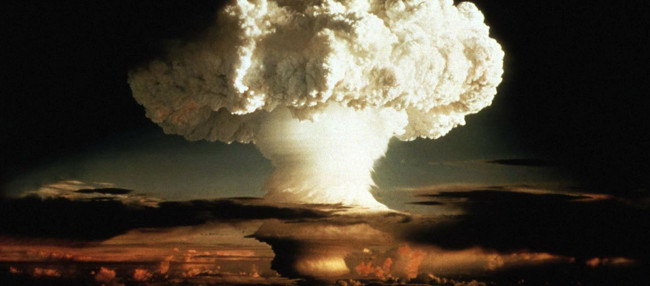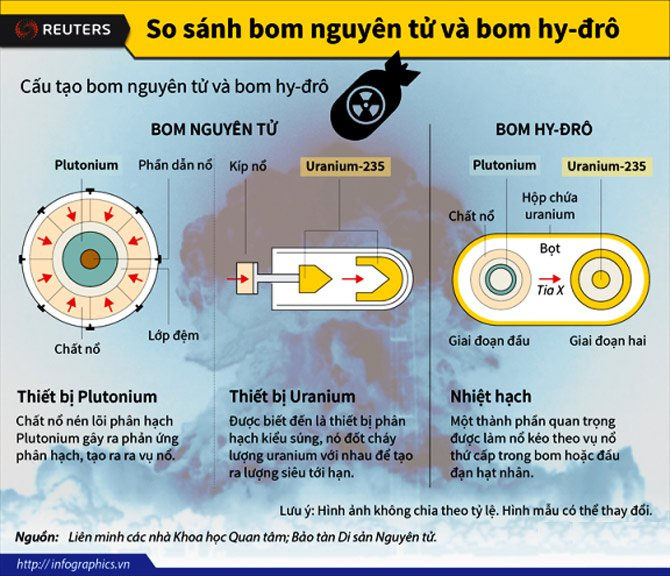Hydrogen bombs, nuclear weapons are 1,000 times more powerful than nuclear bombs
Atomic bombs and hydrogen bombs (thermonuclear bombs) are the two most powerful bombs in the world. According to experts, hydrogen bombs are more powerful than 1000 atomic bombs. Is this true?
Try comparing to see how different atomic bombs and hydrogen bombs look? How destructive is the power of every bomb.
Atom bomb
People have witnessed the tremendous destructive power of atomic bombs when the US dropped two Japanese and Hiroshima bombs on Japan, killing more than 200,000 people.

Nuclear bomb explosion in Nagasaki, Japan.
Atomic bombs create destructive energy thanks to the fission reaction, a phenomenon that divides atomic nuclei into smaller atoms. First, a nuetron - an electrically neutral particle in an atomic nucleus, collides with a plutonium or uranium nucleus, which breaks the nucleus into barium and krypton elements.
This process releases energy in the form of gamma ray radiation, some neutrons and heat. The generated neutrons continue to repeat the division process until the reactive fuel runs out. The time of the chain reaction is only about one millionth of a second.
An atomic bomb has the equivalent of 1,000 tons to several hundred thousand tons of TNT.
Hydrogen bomb (thermonuclear bomb)

Hydrogen bombs rely on the fusion of two light nuclei (hydrogen) into a heavier nucleus (helium). It is this fusion reaction that is happening on the Sun and is the cause of its light and extreme heat.
However, to create this fusion, there must be a great energy. This condition only one atomic bomb explosion can meet. Therefore, the structure of a hydrogen bomb is a double bomb. The atomic bomb must first be exploded to allow the fusion reaction to occur. At that time, a series of atoms combine together, turning into energy with much more destructive power than normal atomic bombs.

Hydrogen bombs have tremendous destructive power. The energy released from a hydrogen bomb explosion can instantly destroy everything within a few kilometers radius. The explosion can create fire storms; High intensity white light can cause blindness; Radioactive dust and by-products can poison living organisms, causing air, soil, and water pollution for hundreds of years.
- Horror secret at the island of humans do not dare to set foot
- What is left of the Earth if all the nuclear bombs in the world fire at the same time?
You should read it
- Scientists have 'thrown' the atomic bomb into beer, soda and drank them
- The width and path of radioactive clouds if North Korea tests the Pacific thermonuclear bomb
- Meteors have the power to destroy 10 billion atomic bombs hitting the Earth at the 'super dangerous' angle, completely eliminating dinosaurs
- Movies have made us look down on bombs and mines like this
- The giant meteorite weighing 40 million tons caused a disaster equivalent to 65,000 atomic bombs about to crash into Earth?
- 5 most powerful nuclear bombs in the world ever built
- Using AI to search for unexploded bombs and mines in Cambodia
- How to use effective stun bombs in PUBG
May be interested
- International Campaign to Eliminate the Nobel Peace Prize for Nuclear Weapons 2017
 the owner of the 2017 nobel peace prize is the international campaign to eliminate nuclear weapons (ican) in an effort to reach a treaty to ban the weapon.
the owner of the 2017 nobel peace prize is the international campaign to eliminate nuclear weapons (ican) in an effort to reach a treaty to ban the weapon. - This is why Elon Musk wants to conduct a 'nuclear attack' on Mars
 elon musk is completely serious with his ambition to conquer the universe, and he really wants to bombard the surface of our neighbor's planet with nuclear weapons.
elon musk is completely serious with his ambition to conquer the universe, and he really wants to bombard the surface of our neighbor's planet with nuclear weapons. - How to use smoke bomb effectively in PUBG
 smoke bomb in pubg is a weapon used by many gamers, due to the great effect in the game.
smoke bomb in pubg is a weapon used by many gamers, due to the great effect in the game. - Japan tests the world's most powerful synthetic nuclear research supercomputer
 japan is launching a cray xc50 supercomputer for advanced nuclear synthesis research, which will begin production this year.
japan is launching a cray xc50 supercomputer for advanced nuclear synthesis research, which will begin production this year. - Top powerful and easy-to-play weapons in PUBG
 top powerful and easy-to-play weapons in pubg. in pubg your victory is greatly supported by powerful guns, take them to have an advantage over your opponents.
top powerful and easy-to-play weapons in pubg. in pubg your victory is greatly supported by powerful guns, take them to have an advantage over your opponents. - 5 most powerful stealth weapons of all time of America
 below are the top 5 us weapons systems rated as 'most powerful of all time' as voted by national interest magazine.
below are the top 5 us weapons systems rated as 'most powerful of all time' as voted by national interest magazine. - How scary is the poison VX, the most terrifying neurotoxin in the world?
 vx is a neurotoxin that is considered to be the most powerful man ever created. it is 100 times stronger than srarin - a deadly poison in minutes in very small doses. the united nations has classified this poison as a list of weapons of mass destruction.
vx is a neurotoxin that is considered to be the most powerful man ever created. it is 100 times stronger than srarin - a deadly poison in minutes in very small doses. the united nations has classified this poison as a list of weapons of mass destruction. - Revealing secrets hidden by the CIA for decades
 there are many secret programs of varying degrees that the government and the us military have been trying to keep secret for years like the world war ii supersonic flying saucer, cat scouts, and particle bombs. human ...
there are many secret programs of varying degrees that the government and the us military have been trying to keep secret for years like the world war ii supersonic flying saucer, cat scouts, and particle bombs. human ... - Hydrogen trains run 2,800km on just one tank of fuel
 the flirt h2 hydrogen train by the swiss company stadler rail traveled 2,800km on just one tank of hydrogen, breaking the travel record in a test conducted in colorado, usa.
the flirt h2 hydrogen train by the swiss company stadler rail traveled 2,800km on just one tank of hydrogen, breaking the travel record in a test conducted in colorado, usa. - Horror secret at the island of humans do not dare to set foot
 a deserted island with blue sea, white sand, golden sunshine but no one has the courage to live here. it was bikini atoll, which had more than 20 atomic bomb tests of the us military from 1946 to 1958.
a deserted island with blue sea, white sand, golden sunshine but no one has the courage to live here. it was bikini atoll, which had more than 20 atomic bomb tests of the us military from 1946 to 1958.










 Scientific perspective: Can people travel time?
Scientific perspective: Can people travel time? Crystals can also be bent and elastic, causing people's perception of the structure to change
Crystals can also be bent and elastic, causing people's perception of the structure to change If stretched all the way, how big are the human organs?
If stretched all the way, how big are the human organs? Why are some people left-handed while most of us are right-handed?
Why are some people left-handed while most of us are right-handed? 5 parts of new scientific world discovered in human body
5 parts of new scientific world discovered in human body 10 great astronomers have made the most important contribution to the astrophysical field of humanity
10 great astronomers have made the most important contribution to the astrophysical field of humanity